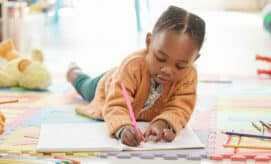Once children have mastered their foundational writing skills, they start to become writers. Researchers call this phase of development emergent writing, which consists of three domains:
-
Conceptual knowledge includes learning the function of writing. Children learn that writing has a purpose and that print/letters carry meaning to communicate a message. An example of this is children becoming aware that the red, octagonal street signs say “stop”.
-
Procedural knowledge takes place when children learn the mechanics of letter and word writing, and develop an understanding of the alphabet (how to form letters and sounds associated with each letter).
-
Generative knowledge is the ability to translate thoughts into writing words, phrases and sentences.
For more detailed information about these three domains, click here to read NAEYC’s article, Promoting Preschoolers’ Emergent Writing.
Activities to Practice Writing Skills
Children learn and gain interest in writing through exposure to print (letters, signs, etc.) in their environment. For teachers to support children’s writing, there should be a variety of opportunities to practice throughout the children’s day.
-
Practice name writing. One of the first words children usually learn to write is their first name — and often, children will express interest in wanting to learn the letters of their own name. Name writing can be incorporated often in the classroom by having children sign their name on their art projects, or by having a sign-in and sign-out sheet where children log their names.
-
Include writing in dramatic play. During pretend play, children often enjoy creating signs for their store, menus for their restaurant, or receipts for their cash register. Dramatic play provides a variety of opportunities for children to practice their writing skills in ways that feel interesting and fun.
-
Give each child a journal to practice writing. Journals offer a great opportunity for children to not only practice their writing skills, but also have a record of their progress throughout the year. Purchase each child a journal for writing, drawing pictures and doing activities throughout the year. The journal will also make a very special keepsake for families to hold onto.
COVID-19 Notes
Practicing writing and fine motor skill activities are also particularly conducive to maintaining social distancing — as they can be practiced individually, with children spaced out from their peers.
To limit sharing materials, keep journals in children’s cubbies with their own pencil or writing utensil. You might also consider having plastic bags of crayons, colored pencils, markers, and other writing utensils for each child to keep in a cubby and use for drawing pictures.
Resources for Further Reading







